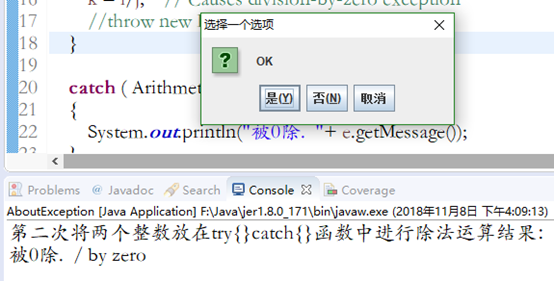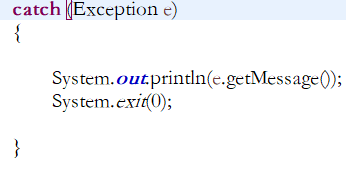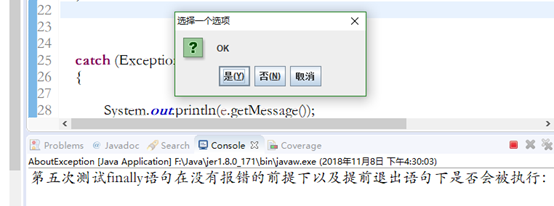AboutException的测试:
1 package test; 2 import javax.swing.*; 3 4 class AboutException { 5 public static void main(String[] a) 6 { 7 @SuppressWarnings("unused") 8 int i=1, j=0, k; 9 //System.out.println("第一次直接对两个整数进行除法运算结果:"); 10 //k=i/j; 11 12 13 try 14 { 15 System.out.println("第五次测试finally语句在没有报错的前提下以及提前退出语句下是否会被执行:"); 16 //System.out.println("第二次将两个整数放在try{}catch{}函数中进行除法运算结果:"); 17 k = i/j; // Causes division-by-zero exception 18 //throw new Exception("Hello.Exception!"); 19 //System.out.println("第三次测试finally语句在没有报错的情况下是否会被执行:"); 20 21 } 22 23 24 25 catch (Exception e) 26 { 27 28 System.out.println(e.getMessage()); 29 System.exit(0); 30 31 } 32 33 34 finally 35 { 36 JOptionPane.showConfirmDialog(null,"OK"); 37 } 38 39 } 40 }
1.第一次


因为0不能作为分母而报错。
第二次

可以看到在try{}catch{}函数中虽然没有报错,但运算结果是将报错信息输出:/ by zero,
可以看出try{} catch{}函数的作用,还可以看到错误的信息。
第三次


可以看到,在程序没有报错的情况下,finally任然会被执行。
第四次


可以看到,在报错的前提下,加入提前退出语句后只输出了错误信息,而没有执行finally语句。
第五次

可以看到,在没有报错的前提下,catch语句不能正常执行,所以提前退出语句不执行,finally语句得以正常执行。
综上所述,有
(1)Finally语句不管有没有异常发生,finally语句都得以运行,但是在遇到提前退出语句后不能被执行。
(2)try{}catch{}函数能将错误信息抛出.
ThrowDemo的测试:
1 package test; 2 public class ThrowDemo { 3 public static void main(String[] args) { 4 // try { 5 double data = 100 / 0.0; 6 System.out.println("浮点数除以零:" + data); 7 // if(String.valueOf(data).equals("Infinity")) 8 // { 9 // System.out.println("In Here" ); 10 // throw new ArithmeticException("除零异常"); 11 // } 12 // } 13 // catch(ArithmeticException e) { 14 // System.out.println(e); 15 // } 16 } 17 } 18
1.第一次测试

没有报错,但是如果将0.0改为0就会有如下结果:

这个错误相比不是很陌生了,因为在上一个测试中我们遇到了无数次这个错误类型,就是因为分母为零,根据Java对double的定义运算,结果为无限。
2.第二次测试

系统抛出新的错误被截取,
3.第三次测试

错误被截取后正常输出。
在这个测试里,第二个catch没有被编译执行。
CatchWho测试:
1 package test; 2 public class CatchWho { 3 public static void main(String[] args) { 4 try { //2 5 try { //1 6 throw new ArrayIndexOutOfBoundsException(); 7 } 8 catch(ArrayIndexOutOfBoundsException e) { 9 System.out.println( "ArrayIndexOutOfBoundsException" + "/内层try-catch"); 10 } 11 12 throw new ArithmeticException(); //扔出新的错误 13 } 14 catch(ArithmeticException e) { 15 System.out.println("发生ArithmeticException"); 16 } 17 catch(ArrayIndexOutOfBoundsException e) { //没有输出,因为前面有一个catch将错误捕捉,这个就不会被执行了 18 System.out.println( "ArrayIndexOutOfBoundsException" + "/外层try-catch"); 19 } 20 } 21 }
测试结果

抛出错误类型。
CatchWho2测试:
1 package test; 2 public class CatchWho2 { 3 public static void main(String[] args) { 4 try { 5 try { //第一次扔出错误 6 throw new ArrayIndexOutOfBoundsException(); 7 } 8 catch(ArithmeticException e) {//截取错误,但没有输出 9 System.out.println( "ArrayIndexOutOfBoundsException" + "/内层try-catch"); 10 } 11 throw new ArithmeticException(); //第二次扔出错误 12 } 13 catch(ArithmeticException e) { //不是正确的错误类型,错误类型不匹配,不输出 14 System.out.println("发生ArithmeticException"); 15 } 16 catch(ArrayIndexOutOfBoundsException e) { //截取错误类型 17 System.out.println( "ArrayIndexOutOfBoundsException" + "/外层try-catch"); 18 } 19 } 20 }
EmbededFinally测试;
1 package test; 2 public class EmbededFinally { 3 4 5 public static void main(String args[]) { 6 7 int result; 8 9 try { 10 //result=100/0; 11 System.out.println("in Level 1"); 12 13 14 try { 15 result=100/0; 16 System.out.println("in Level 2"); 17 // result=100/0; //Level 2 18 19 try { 20 21 System.out.println("in Level 3"); 22 23 result=100/0; //Level 3 24 25 } 26 27 catch (Exception e) { 28 29 System.out.println("Level 3:" + e.getClass().toString()); 30 31 } 32 33 34 finally { 35 36 System.out.println("In Level 3 finally"); 37 38 } 39 40 41 // result=100/0; //Level 2 42 43 44 } 45 46 catch (Exception e) { 47 48 System.out.println("Level 2:" + e.getClass().toString()); 49 50 } 51 finally { 52 53 System.out.println("In Level 2 finally"); 54 55 } 56 57 // result = 100 / 0; //level 1 58 59 } 60 61 catch (Exception e) { 62 63 System.out.println("Level 1:" + e.getClass().toString()); 64 65 } 66 67 finally { 68 69 System.out.println("In Level 1 finally"); 70 71 } 72 73 } 74 75 }
测试结果:

总结:
当有多层嵌套的finally时,异常在不同的层次抛出,在不同的位置抛出,可能会导致不同的finally语句块执行顺序。